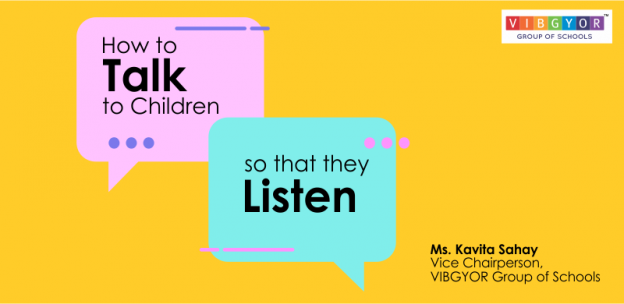![]()
We are well into the New Year 2019 now. As parents and educators, one of our New Year resolutions should be about spending more time talking to children…especially the school going ones – how to talk to them so that they listen, is what worries us most. This would surely be an intriguing topic for some of us, a non topic for others, but it is nonetheless an important one.
The 21st Century has thrown up many challenges, not the least of them being the problem of face to face communication. With the advent of newer means of technology at our disposal and the proliferation of hand held and portable devices for communication on the rampant increase, personal conversations have become rare occurrences with people resorting to con calls, audio and video chats, SMS and Whatsapp messages as well as connectivity on other social media platforms such as Snapchat and Instagram. Even official discussions, meetings, seminars and conferences are now being conducted over Skype and Zoom and other such mediums. Hangouts is one of the ways in which the younger generation actually hangs out! In such a scenario, how do parents and teachers connect with children who are more comfortable with online and virtual conversations than the ones in real life? No wonder some of us may feel a sense of disconnect with our children when in their physical company.
The answer does not lie in resorting to messaging or video calling our children and learners but in using the following simple tips to connect with the children who mean the most to us.
When talking to children we should:
- Smile and greet our children when we meet them at any time of the day. A smile is a great way to connect and radiate warmth that envelops and cheers up the children. When we say ‘Hello’, or ‘Good Morning’, we will get a reply which can then lead on to the next step as the connection is established. Maybe we can even have our own special ways of greeting our children.
- Ask leading to and open ended questions like, ‘So, how was your day?’, ‘What are you thinking about now?’, ‘What is it that I can do for you?’, ‘How have you and your friends been doing in school?’ or even something as simple as, ‘Which subject/time of the day/snack/book/movie do you like the most? And why?’. These can be great conversation starters.
- Give ample time to our child/learner. Set aside time for the conversation. Children too, just like us, love to be heard patiently. Let us respect that. Do not try to close conversations in a hurry. Do not raise your voice. Do not keep looking over their shoulders or here and there while talking. Look at the child/learner in their eyes, but do not stare. That would be disconcerting. Though, one should be firm, in a polite and friendly manner, in case the child/learner does not follow the decorum of the conversation.
- No matter what turn the conversation takes, let us not forget to smile at times, nod our head, use appropriate, non threatening body language, and most importantly, listen to them when they talk so that they may return the favour when we have something to say.
- Speak in a positive, encouraging tone. Instead of asking, ‘Was the test difficult to attempt?’, we should instead ask, ‘Which question in the test did you find the most exciting?’. A statement such as. ’As you haven’t been doing any reading, I don’t think your language will improve!’ could demoralize children and put them off reading. It would be far better to say, ‘Over the holidays you could read this book. It seems to be enjoyable!’.
There are many more ways to make a conversation interesting for children. Let us begin by using these 5 crucial tips which will be most beneficial to us. Let’s begin talking in the way our children would love to listen to us!
